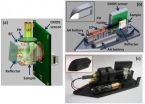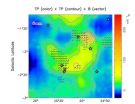(Press-News.org) WASHINGTON, Aug. 30—To serve remote areas of the world, doctors, nurses and field workers need equipment that is portable, versatile, and relatively inexpensive. Now researchers at the University of California at Los Angeles (UCLA) have built a compact, light-weight, dual-mode microscope that uses holograms instead of lenses. The team describes the new device in a paper published today in the Optical Society's (OSA) open-access journal Biomedical Optics Express.
Their prototype weighs about as much as a medium-sized banana and fits in the palm of a hand. And, since it relies in part on mass-produced consumer electronics, all the materials to make it add up to between $50 and $100 USD.
It also has a two-in-one feature: a transmission mode that can be used to probe relatively large volumes of blood or water, and a reflection mode that can image denser, opaque samples. The spatial resolution for both modes is less than two micrometers—comparable to that achieved by bulkier microscopes with low- to medium-power lenses.
"This is the first demonstration of essentially a hand-held version of a microscope that can do dual-mode imaging within a very compact and cost-effective form," says Aydogan Ozcan, an associate professor of electrical engineering and bioengineering at UCLA and senior author of the paper.
With just a small amount of training, doctors could use devices like these to improve health care in remote areas of the world with little access to diagnostic equipment, Ozcan says. The handheld microscope could help ensure water quality, test patients' blood for harmful bacteria, and even be used for semen-quality monitoring on animal farms.
It could also prove useful in health crises such as the recent outbreak of E. coli in Europe.
"It's a very challenging task to detect E. coli in low concentrations in water and food," Ozcan says. "This microscope could be part of a solution for field investigation of water, or food, or maybe pathogens in blood."
Part of the device's success is the weight it shed when researchers got rid of the bulkier, heavier, more expensive pieces that most microscopes rely on for collecting and focusing light: the lenses. Instead of lenses, this microscope uses holograms.
Holograms are formed when light bouncing off (or passing through) a three-dimensional object is made to interfere with a "reference beam," or light that has not hit the object. Consider this analogy: drop a stone into a still pond and the ripples will move outward in a circle. Drop two stones and the circular ripples will interfere with each other, making a new pattern of crests and troughs. A person (or computer) analyzing the interference pattern created by those two stones could trace the source back to the stones and recreate what had happened to make the waves.
The UCLA team's device uses a similar principle to recreate images from interfering light waves.
An inexpensive light source is divided into two beams —one that interacts with microscopic cells or particles in the sample, and the other that does not. The beams then pass to an adjacent sensor chip, where their interference pattern is recorded.
Software then analyzes that pattern and recreates the path taken by the light that passed through or bounced off of the objects being imaged.
Each component of the device is fairly inexpensive, Ozcan says. The laser light could come from a $5 laser pointer. The sensor chip that collects that light is the same as the ones in the backs of iPhones and Blackberrys and costs less than $15 per chip. And the whole image-collecting system runs on two AA batteries.
Where the researchers have reduced weight and expense in doing away with lenses, they have added the power of the cloud. The microscope captures raw data; but a computer is required to reconstruct the images. Workers in the field could use their laptops to process the information or send it over the Internet or mobile phone networks to a remote server. Mobile phones could also have sufficient processing power to do the analysis on the spot.
Essentially, Ozcan says, "we are replacing an expensive and bulky, heavy component with computer codes."
The next steps for Ozcan's team include commercializing the device. Ozcan says he has founded a company that is developing this technology, trying to make a version of the microscopes that can be manufactured and sold to healthcare workers and hobbyists.
"Global health is a big field that requires better diagnostic tools, because resource-poor countries don't have the infrastructure for conducting essentially accurate diagnostic tests," Ozcan says. "There are so many problems that innovative solutions [like this microscope] would impact."
INFORMATION:
Paper: "Field-portable reflection and transmission microscopy based on lensless holography," M. Lee, O. Yaglidere, A. Ozcan, Biomedical Optics Express, Volume 2, Issue 9, p. 2721-2730. http://www.opticsinfobase.org/boe/abstract.cfm?uri=boe-2-9-2721
EDITOR'S NOTE: For images or interviews with authors, please contact Angela Stark, astark@osa.org or 202.416.1443.
About Biomedical Optics Express
Biomedical Optics Express is OSA's principal outlet for serving the biomedical optics community with rapid, open-access, peer-reviewed papers related to optics, photonics and imaging in the life sciences. The journal scope encompasses theoretical modeling and simulations, technology development, and biomedical studies and clinical applications. It is published by the Optical Society and edited by Joseph A. Izatt of Duke University. Biomedical Optics Express is an open-access journal and is available at no cost to readers online at http://www.OpticsInfoBase.org/BOE.
About OSA
Uniting more than 106,000 professionals from 134 countries, the Optical Society (OSA) brings together the global optics community through its programs and initiatives. Since 1916 OSA has worked to advance the common interests of the field, providing educational resources to the scientists, engineers and business leaders who work in the field by promoting the science of light and the advanced technologies made possible by optics and photonics. OSA publications, events, technical groups and programs foster optics knowledge and scientific collaboration among all those with an interest in optics and photonics. For more information, visit www.osa.org.
Microscope on the go: Cheap, portable, dual-mode microscope uses holograms, not lenses
Device described in Biomedical Optics Express could be used for field diagnostics in developing countries, testing of water quality, food contamination
2011-08-31
ELSE PRESS RELEASES FROM THIS DATE:
IU analysis changing diagnosis and management of initial UTIs in young children
2011-08-31
INDIANAPOLIS – Analysis by Indiana University School of Medicine researchers of ten years of scientific studies has resulted in changes in American Academy of Pediatrics recommendations for how initial urinary tract infection in infants and toddlers is diagnosed and treated. This change will affect thousands of children every year.
The findings of the IU School of Medicine investigators argue against exposing all young children who are diagnosed with an initial urinary tract infection (UTI) to a painful radiologic test and against prescribing prophylactic antibiotic treatment ...
The Great Recession could reduce school achievement for children of unemployed
2011-08-31
The Great Recession could have lingering impacts on the children of the unemployed, according to researchers at the University of Chicago.
"There is growing evidence that parental job loss has adverse consequences on children's behavior, academic achievement and later employment outcomes, particularly in economically disadvantaged families," said Heather Hill, assistant professor in the University of Chicago School of Social Service Administration. The material hardship and stress associated with unemployment appears to reduce the quality of the home environment and ...
Future climate change may increase asthma attacks in children
2011-08-31
Mount Sinai School of Medicine researchers have found that climate change may lead to more asthma-related health problems in children, and more emergency room (ER) visits in the next decade.
The data, published in the current issue of the American Journal of Preventive Medicine, found that changing levels of ozone could lead to a 7.3 percent increase in asthma-related emergency room visits by children, ages 0-17.
The research team, led by Perry Sheffield, MD, Assistant Professor of Preventive Medicine at Mount Sinai School of Medicine, used regional and atmospheric ...
Beyond pills: Cardiologists examine alternatives to halt high blood pressure
2011-08-31
More and more, patients show up to appointments with hypertension expert John Bisognano, M.D., Ph.D. carrying bags full of "natural" products that they hope will help lower their blood pressure. And like most physicians, Bisognano doesn't always know if these products will do any good, or if they will cause any harm.
"Right now we're seeing a cultural shift where an increasing number of people want to avoid standard pharmaceuticals," said Bisognano, professor of Medicine and director of Outpatient Cardiology at the University of Rochester Medical Center. "We're also ...
More questions than answers remain concerning effects of airplane travel on insulin pump delivery
2011-08-31
New Rochelle, NY, August 30, 2011—Despite recent concerns that changes in atmospheric pressure during airplane travel may affect the amount of insulin delivered via pump devices, the current evidence is limited and it would be unwise to overreact until more data are available, according to an insightful editorial in Diabetes Technology & Therapeutics, a peer-reviewed journal published by Mary Ann Liebert, Inc. The editorial is available free online.
Irl B. Hirsch, MD, Professor of Medicine, University of Washington School of Medicine (Seattle), and Senior Editor of Diabetes ...
An atlas of the Milky Way
2011-08-31
This press release is available in German.
It may not be much use to hitchhikers through the galaxy, but it is extremely valuable to astronomers: the new radio atlas of the Milky Way. After almost ten years of work, researchers at the Max Planck Society and the Chinese Academy of Sciences have completed their investigation into the polarised radio emission in the galactic plane. The atlas is based on observations undertaken with the 25-metre radio telescope in the Chinese city of Urumqi and shows an area of 2,200 square degrees of the sky.
The radio survey covers ...
FoundUB4 Offers Facebook Advertising Consultancy To Businesses Of All Sizes
2011-08-31
Facebook marketing is an essential component of any complex social media marketing promotion campaign. An increasing number of business owners realize this, but they do not have the relevant knowledge or skills to set up an attractive business page or group that will attract customers.
There is a huge amount of money to be made on the site, and that is why many of them are asking for help from a professional Facebook advertising consultant.
If you have heard success stories about Facebook already, you will know that it is worth the try. Still, you will need to face ...
The diamond planet
2011-08-31
A star that changes into a diamond planet? What sounds like science fiction is apparently reality. The discovery was made by an international team of scientists from Australia, Italy, Great Britain, the USA and Germany, including Michael Kramer from the Max Planck Institute for Radio Astronomy in Bonn. The researchers found the diamond planet with the help of the 64-metre Parkes radio telescope in Australia. The planet apparently orbits around an unusual, very dense star, a pulsar.
Pulsars represent the very last stages of star formation. They are rapidly rotating neutron ...
Accounting Software Resources Available from Red Wing Software
2011-08-31
Red Wing Software, Inc. announces the addition of free accounting software resources to their Web site for customers and prospects alike. Customers can now learn about their software in a wide variety of methods, and prospects can use available tools to find the accounting program that suits their needs more easily, whether it's a Red Wing Software program or not.
Customers can now find a variety of accounting software training tools available at the Red Wing Software University page: www.redwingsoftware.com/rwsu. Customers can join online 'Getting Started' Web learning ...
Golden Riviera is Giving Away 10 Free Spins in Their Latest Promo!
2011-08-31
The home of sophisticated gaming, Golden Riviera Online Casino, has been making gaming enthusiasts happy for over ten years and knows exactly just how to get a gamer's mouth watering with their wicked promotions. This time around they have a promotion that would drive anyone crazy with excitement. They are giving away 10 Free Spins on the spectacular hit Video Slot, Break da Bank Again!
This promotion is open to all newcomers to Golden Rivera Casino and ends on the 31st September 2011.
All they need to do is:
1) Go to Golden Riviera's Facebook page: http://www.facebook.com/goldenrivieracasino ...
LAST 30 PRESS RELEASES:
Do hormones explain why women experience more gut pain?
New materials conduct ions in solids as easily as in liquids
Breakthrough of the Year: Renewable energy begins to eclipse fossil fuel-based sources
LLM use is reshaping scientific enterprise by increasing output, reducing quality and more
Introducing LightGen, a chip for ultra-fast, ultra-efficient generative AI
Astronomers see fireworks from violent collisions around nearby star
ACC/AHA issue new guideline on managing congenital heart disease in adults
Cosmic crash caught on camera
Is talented youth nurtured the wrong way? New study shows: top performers develop differently than assumed
Ants: An untapped resource in the development of antibiotics?
Archaeologists use AI to create prehistoric video game
Mitochondria migrate toward the cell membrane in response to high glucose levels
Tiny viral switch offers hope against drug-resistant bacteria
Most parents aware of early peanut introduction guidelines, but confused about details
HPV vaccine can protect against severe lesions of the vulva and vagina
Virtual care provision and emergency department use among children and youth
Quadrivalent HPV vaccine and high-grade vulvovaginal lesions
Insights into dry eyes gained from stem cell-derived tear glands
Researchers identify 166 human pluripotent stem cell lines available for use in clinical applications
Europa Clipper instrument uniquely observed interstellar comet 3I/ATLAS
UN University Report challenges climate change as sole trigger of Syrian Civil War, exposing governance failures in drought response
Real estate investment trust (REIT) acquisition associated with hospital closure and bankruptcy
New Raman imaging system detects subtle tumor signals
Boston Children’s receives a $7.5 million grant from Aligning Research to Impact Autism (ARIA) to provide clinical research coordination for the IMPACT Network
Spray-on antibacterial coating offers new protection for plants against disease and drought
ESMT Berlin study: What makes a first offer successful in negotiations
Groundbreaking ceremony marks the beginning of CTAO-South Array construction in Chile
Why swearing makes you stronger
What prevents more cancer patients from enrolling in potentially life-saving clinical trials?
UK’s worst-case climate risks laid bare for lawmakers
[Press-News.org] Microscope on the go: Cheap, portable, dual-mode microscope uses holograms, not lensesDevice described in Biomedical Optics Express could be used for field diagnostics in developing countries, testing of water quality, food contamination




